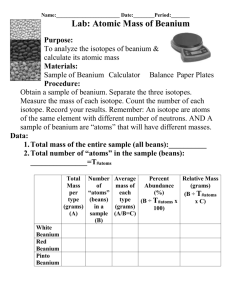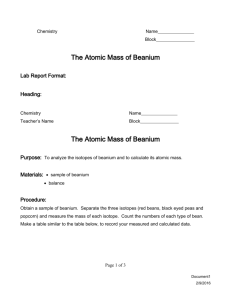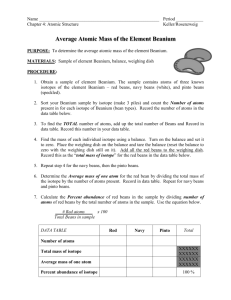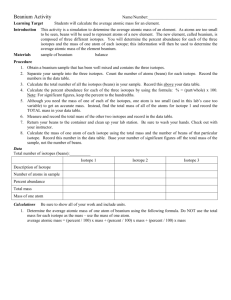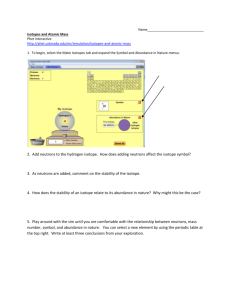Atomic Mass of “Beanium” Lab
advertisement
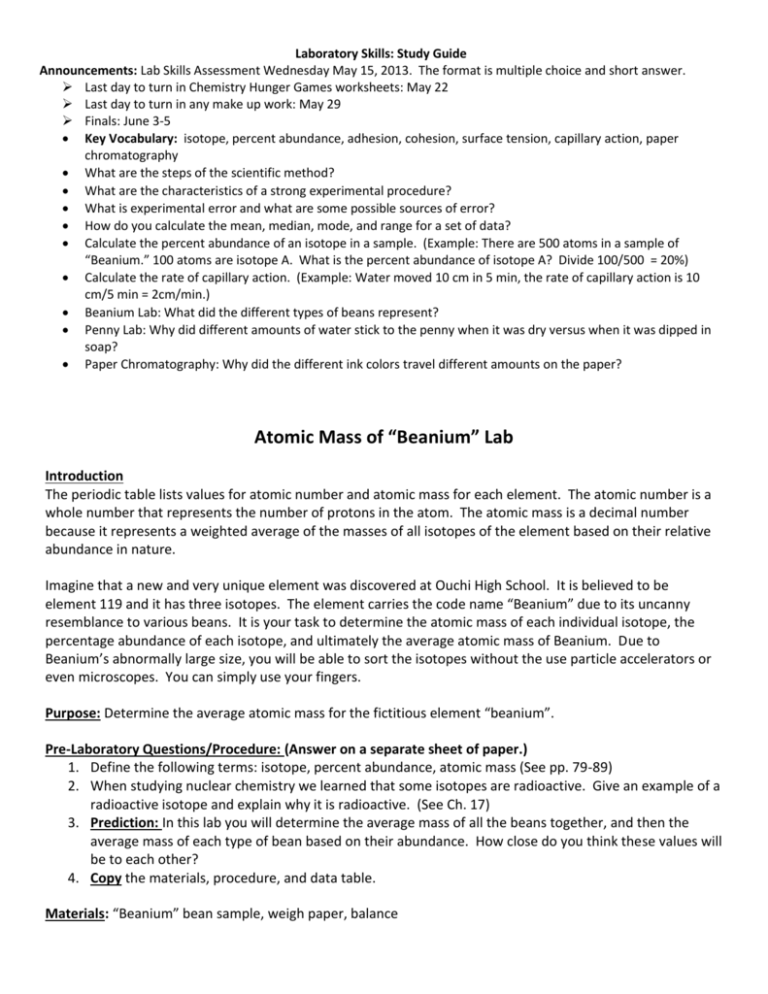
Laboratory Skills: Study Guide Announcements: Lab Skills Assessment Wednesday May 15, 2013. The format is multiple choice and short answer. Last day to turn in Chemistry Hunger Games worksheets: May 22 Last day to turn in any make up work: May 29 Finals: June 3-5 Key Vocabulary: isotope, percent abundance, adhesion, cohesion, surface tension, capillary action, paper chromatography What are the steps of the scientific method? What are the characteristics of a strong experimental procedure? What is experimental error and what are some possible sources of error? How do you calculate the mean, median, mode, and range for a set of data? Calculate the percent abundance of an isotope in a sample. (Example: There are 500 atoms in a sample of “Beanium.” 100 atoms are isotope A. What is the percent abundance of isotope A? Divide 100/500 = 20%) Calculate the rate of capillary action. (Example: Water moved 10 cm in 5 min, the rate of capillary action is 10 cm/5 min = 2cm/min.) Beanium Lab: What did the different types of beans represent? Penny Lab: Why did different amounts of water stick to the penny when it was dry versus when it was dipped in soap? Paper Chromatography: Why did the different ink colors travel different amounts on the paper? Atomic Mass of “Beanium” Lab Introduction The periodic table lists values for atomic number and atomic mass for each element. The atomic number is a whole number that represents the number of protons in the atom. The atomic mass is a decimal number because it represents a weighted average of the masses of all isotopes of the element based on their relative abundance in nature. Imagine that a new and very unique element was discovered at Ouchi High School. It is believed to be element 119 and it has three isotopes. The element carries the code name “Beanium” due to its uncanny resemblance to various beans. It is your task to determine the atomic mass of each individual isotope, the percentage abundance of each isotope, and ultimately the average atomic mass of Beanium. Due to Beanium’s abnormally large size, you will be able to sort the isotopes without the use particle accelerators or even microscopes. You can simply use your fingers. Purpose: Determine the average atomic mass for the fictitious element “beanium”. Pre-Laboratory Questions/Procedure: (Answer on a separate sheet of paper.) 1. Define the following terms: isotope, percent abundance, atomic mass (See pp. 79-89) 2. When studying nuclear chemistry we learned that some isotopes are radioactive. Give an example of a radioactive isotope and explain why it is radioactive. (See Ch. 17) 3. Prediction: In this lab you will determine the average mass of all the beans together, and then the average mass of each type of bean based on their abundance. How close do you think these values will be to each other? 4. Copy the materials, procedure, and data table. Materials: “Beanium” bean sample, weigh paper, balance Procedure: 1. Pick up your sample of Beanium atoms. 2. At your table, separate the three different isotopes. 3. Write a description of each isotope and give each isotope a name. (example name: red bean) 4. Record the names in data table column A. 5. Count the beans of each isotope. Record the total number of atoms and the number of each type of isotope in data table column B. 6. Use the balance to find the total mass of each isotope sample. Record this information in data table column C. 7. Calculate the total mass of the Beanium sample by adding up column C rows 1-3. Record the total mass in column C row 4. 8. Calculate the average mass of a single atom of each isotope. Use the following formula: (mass of beans) ÷ (# of beans). Record the result in column D. 9. Find the percent abundance (% of beans) for each isotope. Use the following formula: (# atoms of isotope) ÷ (total # of atoms) x 100%. Record the result in column E. 10. Atomic mass calculation 1: Calculate the average atomic mass of beanium by dividing the total mass of the beanium sample by the total number of beans. Record the result in column D row 4. 11. Atomic mass calculation 2: Calculate the average atomic mass of beanium based on the relative abundance of each isotope. Multiply the average mass of each isotope by its percent abundance and then adding these values together. Record the result in column E row 4. 12. Clean Up: Place the bean sample back on the counter. Data: DATA TABLE A: ISOTOPE NAME B: # OF BEANS (ATOMS) C: MASS OF BEANS (ATOMS) D: AVERAGE MASS OF 1 BEAN (GRAMS) E: % OF BEANS 1 2 3 4 TOTALS: Weighted Atomic Mass: Data Analysis: 1. Compare the average atomic mass (column D row 4) and the weighted atomic mass (column E row 5). Which calculation more accurately reflects the mass of Beanium? Why? Was your prediction correct? 2. Draw a bar graph displaying the percent abundance of the three isotopes (column E rows 1-3). Label the Y-axis percent abundance and the X-axis with the names of the three isotopes. 3. Rank the isotopes from most abundant to least abundant. 4. Rank the isotopes from least massive to most massive. Conclusions: 1. Which pieces of your data must be measured and which can be calculated? 2. Was the average mass of the beans a whole number or a decimal? Explain. 3. Explain any differences between the atomic mass of your BEANIUM sample and that of a different lab group. Explain why the difference would be smaller if larger samples were used. 4. What is the relationship between an element’s isotopes and the element’s atomic mass? 5. How did this lab simulate the various isotopes of an element. 6. What are at least two sources of error for this activity? (A source of error is an error that could have affected your measurements.) 7. Neon-20 has a mass of 19.9924 amu, neon-21 has a mass of 20.9940 amu, and neon-22 has a mass of 21.9914 amu. The relative abundance of Ne-20 is 90.92%, while Ne-21 is 0.257%, and Ne-22 is 8.82%. Using the same techniques that you used in this lab, calculate the average atomic mass for neon. How does this compare to the value for neon found on the periodic table? 8. Research: Review your nuclear chemistry materials (handouts and Ch. 17). Describe at least three uses of radioactive isotopes. 9. Atomic Mass of “Beanium” Lab: Day 2 – Class Data Analysis Instructions: Fill in the class’s experimental data in the chart below. 10. Data Table 2: Class Experimental Data Group # Red beans # White beans # Pinto beans Weighted Ave. Atomic Mass 1 2 3 4 5 6 7 8 9 10 11 12 Total: Class Data Analysis: Use a separate sheet of paper. Show all your work. 1. Calculate the percent abundance of each isotope (type of bean) for the whole class. (Hint: divide the total # of isotope by the total number of atoms (beans).) 2. Create a bar or pie graph displaying the percent abundance of each isotope. Remember to title your graph and label the axes or segments of the pie. 3. Compare and contrast the class percent abundance data and your group’s data. 4. Find the mean, median, mode and range for the “weighted average atomic mass.” Beanium’s Mysterious Properties: In order to determine Beanium’s placement on the periodic table, scientists examined the chemical properties of Beanium (Bn). According to the observations below, what periodic table group should Beanium join? Explain your answer. (Hint: Your choices are alkaline metals, alkali earth metals, transition metals, group 14, group 15, group 16, halogens, or nobel gases.) Observations: At room temperature, Beanium (Bn) is a diatomic gas. Beanium (Bn) reacts with Cesium to form an ionic compound with the formula NaBn. Bn forms a covalent compound with hydrogen, which acts as a strong acid in solution. Radioactive Decay of Beanium – 300: Scientists discovered an extremely radioactive 4th isotope of beanium called Beanium -300 because it has 119 protons and 181 neutrons for a total atomic mass of 300. Write the nuclear chemical reaction equation for the alpha decay of Beanium-300. Investigation: How many drops of water can a penny hold? Instructions: Work with a partner. Complete all your work for this lab on a separate sheet of paper. Introduction: In this activity, you will investigate the cohesive and adhesive properties of water. Recall that water is a molecule formed by covalent bonding between an oxygen atom and two hydrogen atoms. Water is polar because the oxygen atom pulls the electrons that it shares with the hydrogen atoms more tightly towards it. This creates a slight positive charge on the hydrogen atoms and a slight negative charge on the oxygen atom. Several unique properties of water are due to water’s polar nature. Purpose: Determine the number of drops of water a penny can hold. Pre-Lab Questions: 1. Define cohesion, adhesion, surface tension, and capillary action. 2. Explain the relationship between hydrogen bonding and cohesion, adhesion, and capillary action. 3. Prediction: How many drops of water can fit on one side of a penny? 4. Copy the purpose, materials, procedure, and data tables. Materials penny paper towel water dropper spoon or tweezers testing liquid Procedure Part 1: Perform a CONTROL test for comparison with later results. 1. Rinse a penny in tap water and dry completely. 2. Place the penny on paper towel. 3. Use the dropper to place drops of water on the penny (one at a time) until ANY amount of water runs over the edge of the penny. 4. Record the number of drops for the trial in Data Table 1. 5. Repeat steps 1 through 4 for 4 trials. 6. Calculate the average number of drops and record the result in Data Table 1. Data Table 1 Trial 1 Trial 2 Trial 3 Trial 4 Average Part 2: Perform tests with the TESTING LIQUID. 1. Rinse a penny in tap water and dry completely. 2. Dip the penny into the TESTING LIQUID. Allow the extra liquid to drip off the penny. 3. Place the penny on a dry spot of paper towel. Place drops of water on the penny (one at a time) until ANY amount of water runs over the edge of the penny. 4. Record the number of drops for the trial in Data Table 2. 5. Repeat steps 1 through 4 for 4 trials. 6. Calculate the average number of drops and record the result in Data Table 2. Trial 1 Trial 2 Data Table 2 Trial 3 Trial 4 Average Lab Investigation: Paper Chromatography Introduction Chromatography is the technique of passing a liquid or gaseous mixture over or through an adsorbent material that adsorbs the different components of the mixture at different rates in order to identify those components. Paper chromatography involves using chromatography paper through which a solvent passes using capillary action. The paper is referred to as the “stationary phase” and the solvent is referred to as the “mobile phase” because it moves across the paper. In this lab, we will use paper chromatography to separate the colored dyes that make up various marker colors. Capillary action occurs when the adhesion force of a substance is greater than the cohesion force of that substance. In this case, the solvent and the dissolved marker dyes will move up the chromatography paper by capillary action because they are more attracted to the paper than they are to themselves. We will see that different color dyes have different adhesion forces leading to different amounts of travel up the chromatography paper. Chromatography is a commonly used lab technique for separating mixtures. Purpose: Separate colored marker dyes using paper chromatography. Pre-Lab Questions: Record all your work on a separate sheet of paper. 1. What is the difference between adhesion and cohesion? 2. In your own words, explain the relationship between capillary action and paper chromatography. 3. What are the primary colors? What colors mix to make green, orange, and purple? 4. Prediction: Which marker colors do you think will contain more than one dye color? 5. Copy the purpose, materials, and procedure onto your paper. Materials: 4 pieces chromatography paper, markers, water, bin or beaker, tape, ruler Procedure: 1. Fill a bin or beaker with three centimeters of water. 2. Obtain four pieces of chromatography paper. 3. Tape the strips of paper onto the ruler and trim them to be the same size. 4. Obtain four colored markers and place a different color mark two centimeters from the bottom of each strip. Blow on each of the colors to be sure they dry completely. 5. Place the ruler across the bin so that the strips of paper are touching the water. The marker ink should not touch the water. 6. When the water has climbed to the top of each strip remove the strips and let them dry. Data Analysis and Conclusions 1. Draw a picture of your strips. Clearly label the starting colors and the component colors that separated. 2. Did any of the markers contain the same dyes? How do you know? 3. Compare your results to another group that tested at least one different colored marker. Draw picture of the different color strip. How does it compare to your results? Does it share a dye with a color you tested? 4. Compare your results to your prediction. Were you correct? What was surprising to you? 5. Why do you think the colors separated the way that they did? (Use the terms adhesion, cohesion, and capillary action in your answer.) Part 2: Designing an Experiment Purpose: Determine the rate of capillary action for various types of paper. Experimental Question: If different types of paper are placed in water, how will the rates of absorbance compare? Available Materials: water, ruler, a variety of paper strips, plastic bin or beaker, tape. Procedure: Write a procedure to test the experimental question posed above. The procedure must meet the following criteria: Your procedure should be a numbered list. Each line should give one direction. The directions must be detailed, so that any high school student could easily follow the procedure and conduct the same experiment. *Hint: To find the rate of absorbance, the experiment must measure the time it takes for water to travel up the paper. Consider marking the water height at set time intervals and including a data table to organize the data. *Hint: A strong experiment tests one variable at a time. The tested variable in this experiment is the type of paper. The methods used to test each type of paper should be exactly the same. Type of Paper 1 min Sample Data Table: 2 min 3 min 4 min 5 min Observations:



